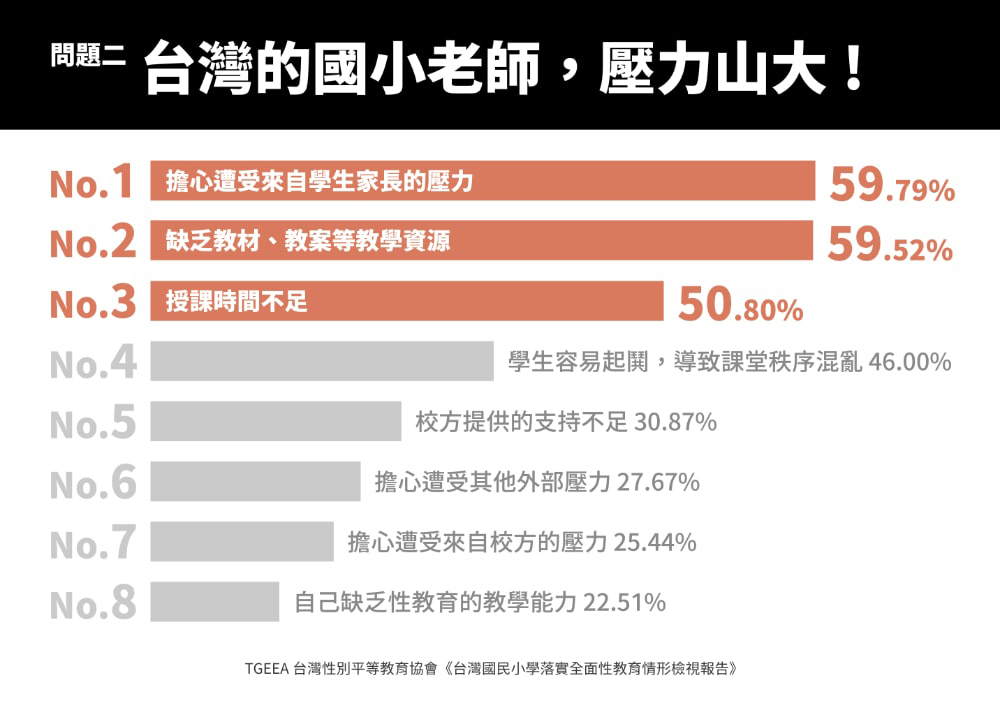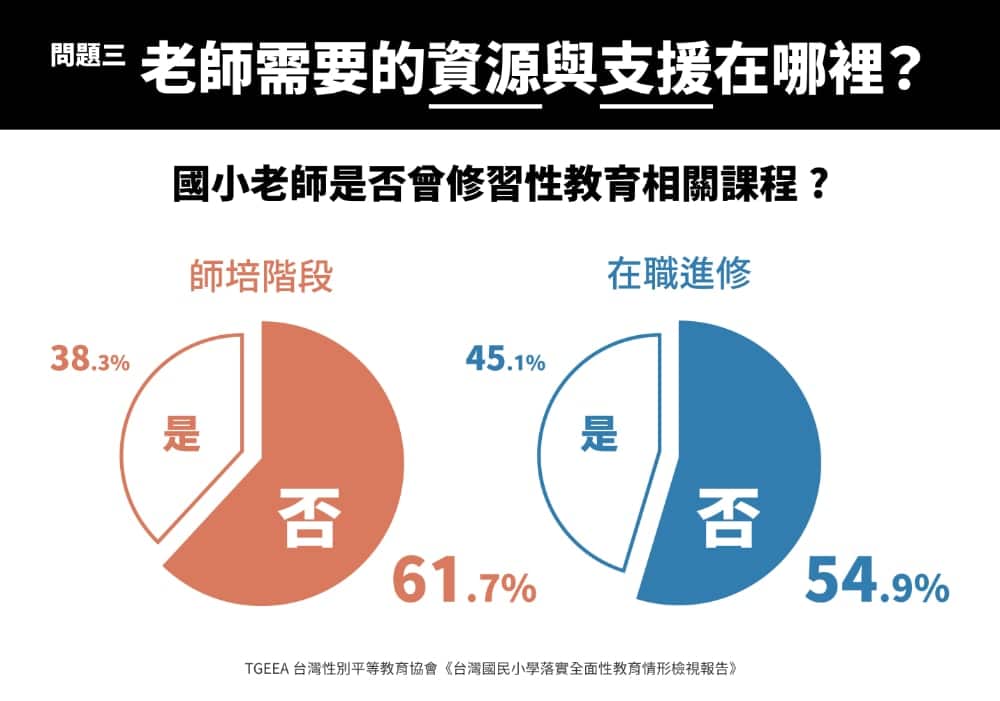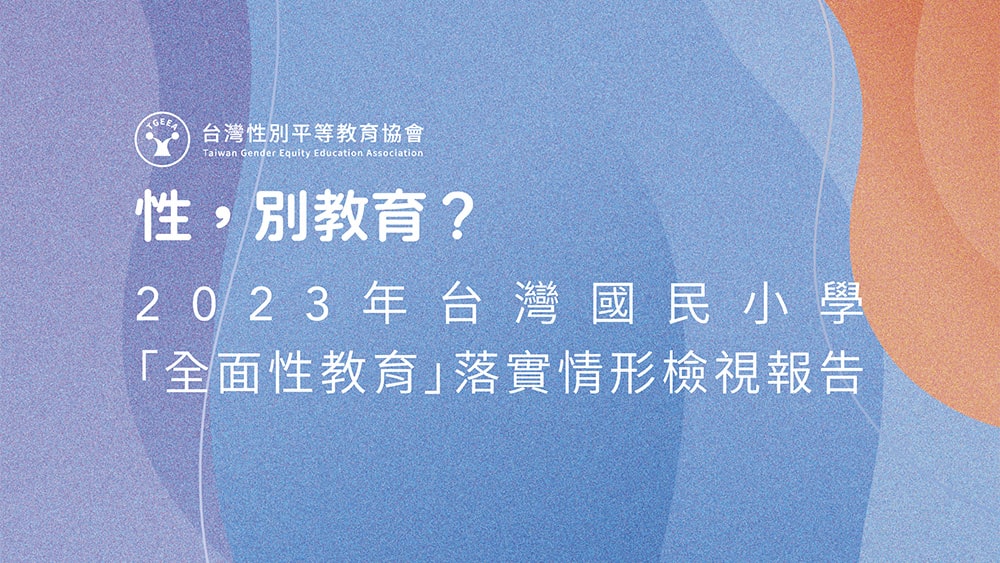摘要
本研究旨在釐清台灣國小現行性教育與 UNESCO 所提倡的全面性教育,二者之間是否以及有何落差;並透過問卷調查與焦點團體,深入了解當前國小教師實施性教育,可能面臨哪些困境,又是如何因應。
本研究發現,全人性教育與全面性教育在核心精神和學習目標上存在差異。全人性教育強調以愛為基礎,旨在實現家庭和社會的和諧;而全面性教育以人權和性別平等為基礎,旨在促進年輕人的健康、福祉和尊嚴。對比兩者所涵蓋的範圍,發現當前台灣國小課程未能完全涵蓋全面性教育的八大核心概念,其中「性與性行為」和「性與生殖健康」兩個核心概念在小學課程中幾乎消失。這導致在教科書當中,與全面性教育相關的內容也偏重於「關係」、「健康與福祉技能」和「理解社會性別」等三個核心概念,占總體的 58%;而「性與性行為」和「性與生殖健康」相關概念僅分別提及了 2 次和 5 次。此外,全面性教育相關主題有超過七成出現在高年級教科書,低年級則僅 4.6% 低年級僅占 4.6%。

另一方面,本研究從現場國小教師的經驗調查中發現,國小學生確實有性教育的需求。老師們大多是因為察覺學生對性的好奇,或者發現學生已經開始接觸色情資訊、模仿具性意涵的言行,甚至已有性行為,而開始實施性教育。並且,有 95.73% 的老師認為,在國小階段實施全面性教育是必要的。然而,國小老師們要實施性教育,面臨外部壓力、缺乏資源、知能不足等困境。

近六成國小老師擔心實施性教育會遭受來自學生家長的壓力,13.88% 曾實際被家長、校方等要求避免教授某些性教育的主題。同樣也有近六成國小老師認為缺乏實施性教育時教材、教案等教學資源,50.80% 的老師則擔心授課時間不足的問題。此外,現階段國小教師對於全面性教育的知能恐怕並不足夠,國小老師對全面性教育缺乏認識、自身性知識未能與時俱進,且所受的性教育相關訓練也不足,近四成填答者在師培階段與在職進修階段皆不曾受過性教育相關訓練。

針對外部壓力,老師們發展出不同的因應策略,包含在談性教育時僅點到為止、加強親師溝通,以及透過校務會議等機制取得教學正當性等。針對教材不足或內容不佳的問題,有些老師將之轉化為機會教育的素材,與學生討論其中的謬誤,也有些老師自行尋求外部資源,例如利用網路影片、與性別倡議組織合作等。
綜上所述,向大眾推廣全面性教育的概念,協助國小教師減輕實施性教育時所面臨的外部壓力,同時發展以學習者為中心的教學資源,並且強化教師接受性教育相關培訓的動機,應是落實全面性教育的當務之急。
Abstract
This study examines current sexuality education in Taiwan’s elementary schools and comprehensive sexuality education (CSE) as advocated by UNESCO to identify discrepancies, if any, between the two programs. Through the use of data collected from surveys and focus groups, this study explores the difficulties elementary school teachers face in implementing sexuality education and the ways in which they cope.
This study has found that holistic sexuality education and CSE differ in terms of central philosophies and learning objectives. Holistic sexuality education is based on love and aims to promote harmony in the family and society. CSE, on the other hand, is based on a human rights and gender equality approach and aims to promote the health, well-being and dignity of young people. In terms of scope, Taiwan’s elementary school curriculum does not cover all eight key concepts of CSE, and two of the concepts (i.e., sexuality and sexual behavior; sexual and reproductive health) are almost entirely excluded from the elementary school curriculum altogether. As a result, the majority of CSE content in textbooks (58%) focuses solely on the key concepts of relationships, skills for health and well-being, and understanding gender, while key concept seven (sexuality and sexual behavior) and key concept eight (sexual and reproductive health) were only mentioned two and five times, respectively. In addition, while 74.8% of CSE topics appear in upper elementary (grades five and six) textbooks, only 4.6% of these topics are included in the lower elementary (grades one and two) textbooks.
Survey responses from practicing elementary school teachers revealed that teachers do believe there is a need for sexuality education in elementary schools. Most teachers decide to initiate sexuality education when they recognize students have begun to display curiosity towards sexuality, have been exposed to explicit sexual content, have started imitating explicit or suggestive language/behaviors, or have even already begun to engage in sexual activity. Even though 95.73% of teachers believe that CSE is necessary at the elementary school level, teachers often face obstacles when attempting to implement sexuality education, such as backlash or external resistance, lack of resources, or their own inadequate knowledge/skills.
Nearly 60% of elementary school teachers reported they were concerned about negative parent reactions to the teaching of sexuality education. 13.88% of teachers had actually been asked by parents and school administration to avoid teaching certain sexuality education topics. In addition, at this point in time, many elementary school teachers may not be equipped with the knowledge necessary to implement CSE. Not only is there a lack of awareness on the subject, much of what they have previously learned about sexuality is outdated, and they have not received sufficient training. In fact, nearly 40% of respondents reported they had not received sexuality education-related training in their pre-service or in-service classes. Even if teachers were knowledgeable enough on the subject, nearly 60% of elementary school teachers reported that there is a lack of teaching resources, such as materials and lesson plans, for the implementation of sexuality education. Survey responses also indicated there was a lack of time allocated to the subject, with 50.8% of teachers expressing such concerns.
When facing external backlash or resistance, teachers seem to have developed various coping strategies. Some merely touch on sexuality education and move on; others try to strengthen parent-teacher communication; and some teachers attempt to legitimize their lessons by going through school mechanisms. As for the issue of insufficient materials, some teachers seek external resources on their own, such as through online videos or by working with gender organizations. Others reported they address poor teaching materials by tackling the problematic content head on and discussing it with students, thereby using it as an educational opportunity.
In conclusion, publically promoting CSE could help reduce the pressure on elementary school teachers implementing sexuality education and developing learner-centered teaching resources and incentivizing teachers to participate in sexuality education training should be a top priority to achieve CSE implementation.


